|
| |
| |
| |
Warmth in Cold Stone
The Architectural Paintings of Pieter Saenredam
If you close your eyes in the Dutch Painting gallery of a great museum and allow your built-in thermometer to guide you, the warmest glow in the room will lead you to Rembrandt. Rembrandt used the reddest, warmest palette of any Dutch painter. His subjects are fuller of flesh and blood and emotion. His large figures emanate body heat that you can feel across the room. Some like it hot.
And some like it cold. Walk to the coolest spot and you will find your way to the distinctive realm of Pieter Saenredam (1597-1665). When you open your eyes, the first thing you see will be the empty interior of a stripped and whitewashed Gothic church. Peering through the arches and down the aisles, you will discover diminutive figures, bundled up in overcoats against the chill, doing not much of anything. You will be impressed by the artist's abilities in perspective (the coldest, most calculating skill in art), and captivated by the transparent design of his composition, the restraint of his colouring. If your reaction is typical, Saenredam's minimalism will remind you of Dutch Calvinism, a religion of renunciation. You will see him as an arch-realist who was nonetheless a poet, an artist who transferred visual facts onto panel so precisely and with such dedication that his work acquires an unintended and therefore all the more touching beauty. If this was your image of Saenredam, you would be in good company, the company of thinkers like Roland Barthes and Umberto Eco. Eco associates Saenredam's work with the concept of ‘materialistic ecstasy’. ‘Saenredam's cathedrals’, he has written, ‘speak to us of the dumbfounding silence of a metallic and material light, pure appearance that celebrates itself’. A beautiful thought. But is it true?
If you were conducting your experiment in the Louvre, the Saenredam before you would be an interior from 1630 of the St. Bavokerk or Great Church in Haarlem. Built in the late fourteenth century as an overgrown parish church, the St. Bavokerk became a cathedral when Haarlem was made a bishopric in 1561. This status was lost in 1578, when the town government fell to the Reformed party. Since then, it has been run by a church council which sees to it that only Reformed services are conducted, alongside other appropriate activities.
| |
| |
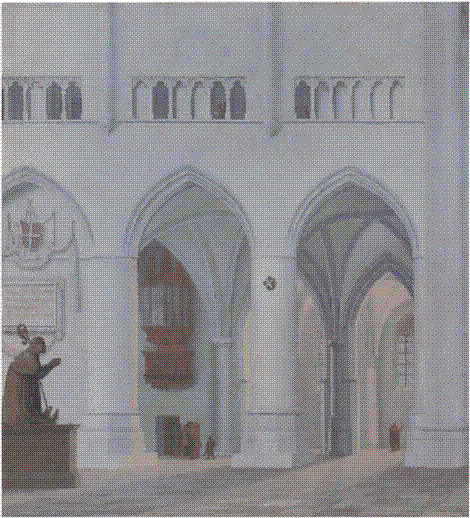
Pieter Saenredam, View across the choir of the St. Bavokerk, Haarlem, from north to south, with a fictive bishop's tomb. 1630. Panel, 41 × 37.5 cm. Musée du Louvre, Paris.
The draughtsman took his stance against the northeast pier of the crossing of nave and transept. A bleak light streams through the southern windows opposite, casting dim shadows in the vaulting and across the floor of the nave. From right to left, step by step, the picture space grows shallower. The view through the first arch on the right pierces the interior to the street wall of the Brewers' Chapel. There, even after the Reformation, the mighty brewers' guild retained an upstairs office. Two men are looking at something on the wall. An everyday scene, perhaps. In the middle arch our gaze is stopped at the outer wall of the side aisle, to which a small organ is attached. A group of men dressed in medieval costume stands in conclave, attended exotically (was this too everyday?) by a little boy with a turban and sword.
That brings us to the leftmost arch, which is closed at the nave itself by a wall adorned by a plaque and coat of arms, in front of which is the kneeling statue of a bishop. Here Saenredam uses his powers of persuasion to lend verisimilitude to a view that never existed. No such statue ever stood in the St. Bavokerk, no such inscribed plaque. The arch was never closed off by a wall. Yet, so convincing is Saenredam's manner that even specialists have been fooled. In 1910, the Utrecht archivist Samuel Muller Fz., in his absolute belief in Saenredam's realism, went so far as to affirm that if Saenredam painted a wall and statue, he for one was prepared to believe they were there
| |
| |
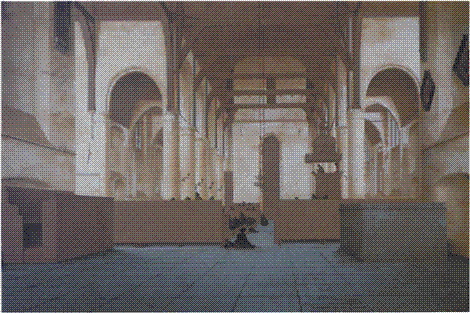
Pieter Saenredam, Crossing and nave of the St. Odulphuskerk, Assendelft, from the right side of the choir. 1649. Panel, 50 × 76 cm. Rijksmuseum, Amsterdam (on loan from the city of Amsterdam).
even in the absence of other evidence. (But there is other evidence - all of it negative). As recently as 1976, the distinguished American art historian Walter Liedtke, unable to conceive of a positive connection between Saenredam and Catholicism, wrote that the Latin inscription - which unequivocally praises the ‘true (Catholic) doctrine’ of the bishop - was anti-clerical.
Once having been apprised of these facts, we may be inclined to tell ourselves that there was something fishy all along about the left part of the painting. The statue looks as though it might have been invented by Saenredam, after all. It is also placed rather strangely, isn't it? The plaque clearly refers to the bishop, and seems to hang directly above it, even being cut into by the mitre. But if we reconstruct the space, we see an altogether different situation. The front of the statue base is aligned not with the blind arch and not even with the column abutting it, but with the base of the middle column. The monument is located in the middle of the nave, at a considerable distance - and at a diagonal - from its inscription.
That was an early painting. By the next time he painted a bishop's statue, sixteen years later, Saenredam was more accomplished at the seamless integration of what was there and what was not. His Choir of the St. Janskerk, 's-Hertogenbosch in the National Gallery of Art in Washington contains no inconsistencies between the second and third dimensions. It breathes the air of unimpeached authority that only the testimony of a professional observer
| |
| |
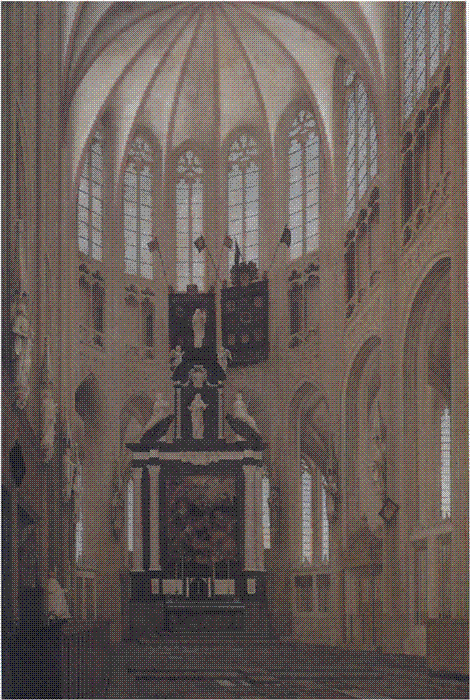
Pieter Saenredam, Choir of the St. Janskerk, 's-Hertogenbosch. 1646. Panel, 128.8 × 87 cm. National Gallery of Art, Washington, dc (Samuel H. Kress Collection).
can convey. One has to be familiar with Dutch history to know that in 1646 the St. Janskerk, which Saenredam shows with its altar set for the mass, had long been Protestantized. And one has to be a specialist in Dutch painting to know that the Adoration of the shepherds that serves as altarpiece is a Saenredam concoction based on a much smaller painting by Abraham Bloemaert (1564-1651), with different figures and from another church.
Before you reverse your first impression altogether, and decide that Saenredam was a Jesuit sophist in disguise, let us admit that the picture of the artist as a close observer and a Calvinist is not altogether erroneous. He was more of a Calvinist than a Catholic, and his depictions of buildings are more reliable than unreliable. Our aim in jolting you with the above examples
| |
| |
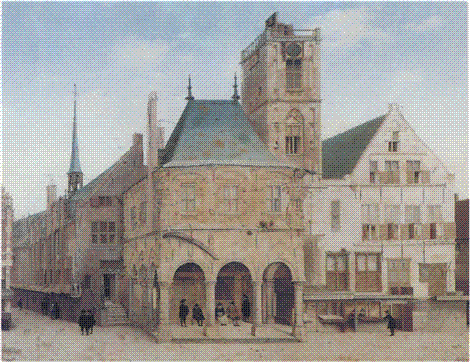
Pieter Saenredam, The old Town Hall of Amsterdam. 1657. Panel, 64.5 × 83 cm. Rijksmuseum, Amsterdam (on loan from the city of Amsterdam).
was to make it clear that neither of those two principles - Calvinism and true-to-life representation - was a guiding light to Saenredam the painter. Nor were any of the other parts of his artistic personality that have sometimes been taken for the whole: devotion to architecture, fascination with painted space, urge to be alone and not bothered by people and their demands.
That last attribute is perhaps the most appealing. Which of us does not sometimes dream of shutting ourself off from others, following our own creative instincts to the limit, and winning immortality in the process? Something about Saenredam's art gives us the feeling that this is what he did. The wish has been projected onto him by some of his admirers, including, we suspect, Umberto Eco, with his ‘materialistic ecstasy’.
Cruel as it may be to dispel that captivating image, our scholarly conscience allows us no alternative. Our research has revealed a Pieter Saenredam who was not only a man of flesh and blood but also a social being like the rest of us. His art was not a hobby, a private vision, or a bid for the attention of posterity over the heads of his contemporaries. It was an occupation that meshed with his apparently very satisfying life as a burgher and a professional.
Saenredam was born for a life in art. His father Jan Saenredam was one of the foremost engravers of Holland in an age when engraving was considered a high-ranking artistic technique, and when the engravers of the
| |
| |
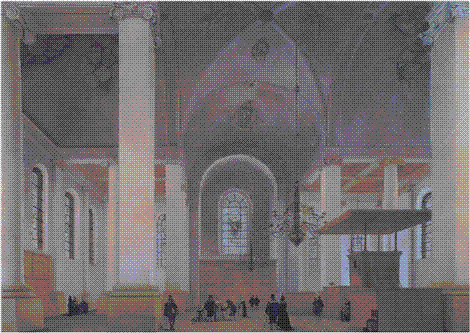
Pieter Saenredam, Interior of the Nieuwe Kerk, Haarlem, from west to east. 1652. Panel, 65.5 × 93 cm. Frans Hals Museum, Haarlem.
Netherlands were acknowledged to be the best in the world. Jan was a star pupil of the legendary Haarlem artist Hendrick Goltzius (1558-1617), and when Goltzius gave up the engraving burin for the painter's brush in 1600 Jan found himself at the very top of his profession. Tragically, he lived for only another seven years before succumbing at the age of 42 to a lung disease.
Pieter, an only child of nine at the time, could not well have known how highly his father was regarded in Haarlem, Amsterdam and all the farflung art centers of Europe where the publishers of those cities sold his prints. What would have made more of an impression on him is how important he was in the village where they lived, Assendelft. Jan was an elder of the church council and the cousin and adopted son of the sheriff, a mighty official answerable only to the lords of Assendelft in their castle. The sheriff, Pieter Jansz. de Jonge, was a leading figure in a clan of officeholders all over the Zaanstreek - the soggy countryside north of Haarlem, with its rich grazing land and shipyards. From the mid-sixteenth century on, they filled not only high village office throughout the area, but also occupied administrative and engineering positions for the Water Board and preached to the Reformed communities of the region.
After his father's death, Pieter was taken by his mother to Haarlem, where he was apprenticed to a painter and began working his way up to the status of a master artist. Yet his descent from those petty lords of the Kennemerland
| |
| |
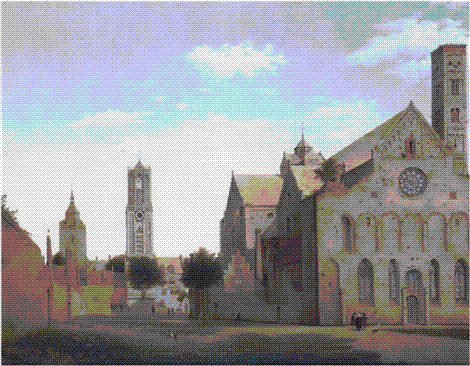
Pieter Saenredam, The Mariakerk and the Mariaplaats, Utrecht, with a view of the Domtoren and the Buurkerk. 1662. Panel, 110.5 × 139 cm. Museum Boymans-van Beuningen, Rotterdam.
muck stood him in good stead all his life. Through marriages with Haarlem patrician families, Saenredam's relatives made their way into the burgomastership of the city where he lived. It was to these connections that he owed his own election to the deanship of the Haarlem painters' guild, a post which he filled energetically and activistically, and his entrée into the circles of the wealthy Haarlem regents in whose collections we encounter the first mention of several of his paintings of Haarlem churches.
We do not subscribe to a deterministic view of the formation of individuals or society. Yet we cannot help observing how well Pieter Saenredam's life fitted the mould pre-shaped by his family background. This painter of churches and town halls was the son of an artist and the cousin of men who ran town halls and churches, and spoke from their pulpits. He embraced this inheritance, let it fill his life with people and their needs, and in turn filled it with meaning in his art.
No more eloquent demonstration of the interweaving of art and social life can be imagined than Saenredam's interior of the church of Assendelft, now in the Rijksmuseum. It depicts a building for which the artist's father and uncle were responsible during their lifetimes, and in which his cousins preached. The lords of Assendelft, to whom they answered (and for whose chapel his father painted a panel), are present in the painting in the stone of their family tomb on the right and the wood of their bench of honour on the left. Between those two markers, in the floor, is a slab engraved ‘Here lie the
| |
| |
remains of Jan Saenredam, celebrated engraver, Pieter de Jonge, sheriff of Assendelft for 44 years, his son Gerrit de Jonge, doctor of jurisprudence and attorney’.
Dear Umberto Eco, is Saenredam's loving depiction of this stone and wood and slate a testimony to materialism, to appearance celebrating itself? We beg to differ. Saenredam's artistry, inherited from his father, was dedicated to his father's memory and to the interests of the people in his life. Those interests were sometimes material. Saenredam painted the town hall of Amsterdam for the burgomasters who met there; the New Church in Haarlem for regents who served on its council; the Mariakerk in Utrecht for families who derived benefices from its ancient chapter. In doing so, he obviously took pleasure in evoking light and space and surface and in his own skill in the mechanics of representation. But his art, like the art of any traditional society, celebrated not material appearances but human interests. And the longer you look at it, the warmer it gets.
gary schwartz and marten jan bok
| |
Further reading
schwartz, gary & bok, marten jan, Pieter Saenredam. The Painter and His Time, London, 1990. |
|